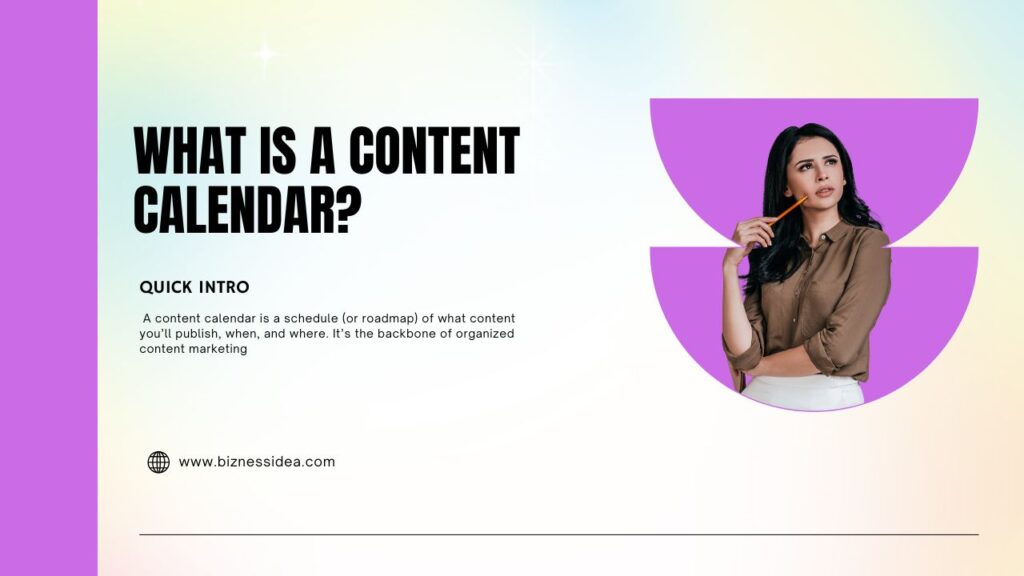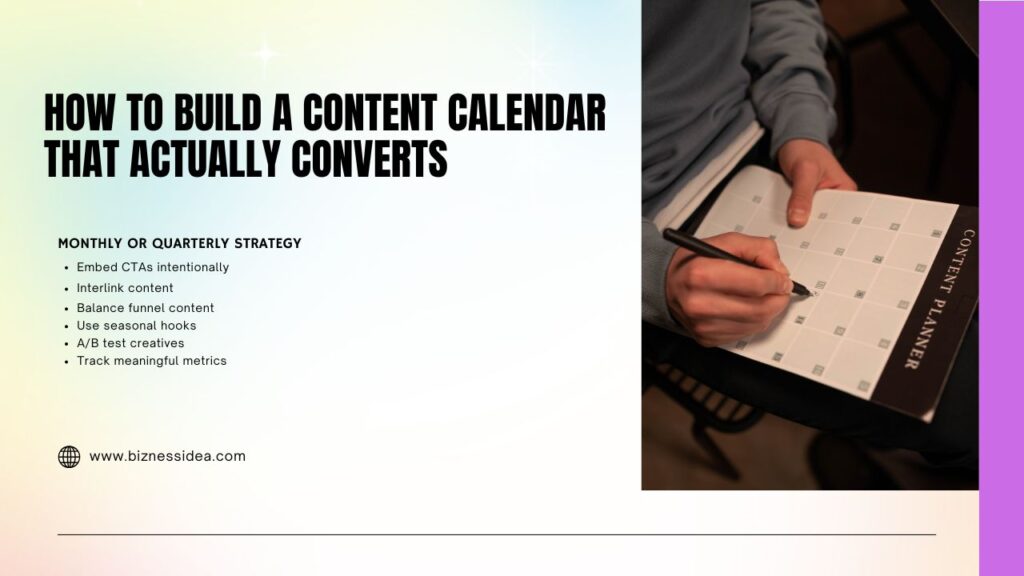If you want your content efforts to move beyond just publishing — to convert readers into leads or customers — you need more than ideas. You need structure, consistency, and strategy. In this post, you’ll learn how to build a content calendar that truly converts. We’ll walk through what a content calendar is, how to create a content calendar step by step, how a social media content calendar fits in, and include a free social media content calendar template 2025 you can adapt.
Whether you’re a startup founder, a small business owner in India, a B2B marketer, or acontent lead, this framework applies — because conversion is universal.
What Is a Content Calendar — And Why It Matters

Before we dive in, let’s clarify: a content calendar is a schedule (or roadmap) of what content you’ll publish, when, and where. It’s the backbone of organized content marketing. (Source: Backlinko)
A social media content calendar is a subset that focuses on posts for platforms like Instagram, LinkedIn, X, TikTok, or YouTube. It ensures you’re not scrambling daily for ideas but are instead posting with purpose.
Why it matters:
- Consistency: Keeps your audience engaged and algorithms happy.
- Strategic alignment: Ties content to business goals, campaigns, and promotions.
- Collaboration & clarity: Helps teams work in sync and prevents duplication.
- Conversion potential: A planned calendar allows you to place CTAs intentionally.
Without a content calendar, even the best ideas can feel scattered. With one, every post works like a building block toward your business goals.
How to Create a Content Calendar — Step by Step
Here’s a practical process for how to build a content calendar that works.
1. Define business goals & content objectives
Every effective content calendar begins with clarity. Do you want more leads, higher signups, improved engagement, or stronger brand awareness? For example, a SaaS startup may use its calendar to align all posts around trial signups, while a retailer may focus on seasonal sales.
2. Understand your audience & content themes
Without audience insight, your calendar will lack direction. Define who you’re talking to — their challenges, habits, and goals. Then create content pillars or themes like tutorials, case studies, product explainers, industry trends, and customer stories. These act as guideposts when generating content ideas.
3. Audit existing content
Before planning new content, review what you’ve already produced. Which blogs drove traffic? Which social posts had the most shares? A content audit helps you identify gaps and opportunities so you don’t reinvent the wheel.
4. Choose channels & formats
Pick where to focus. For B2B companies, LinkedIn and blogs are key. For B2C, Instagram, YouTube, or TikTok may deliver better ROI. Also, decide on formats — blog articles, carousels, reels, infographics, or webinars.
5. Set your cadence & publishing schedule
A realistic posting frequency ensures long-term sustainability. Instead of aiming for daily posts across every channel, start with a pace you can maintain. For example, 2 blogs + 3 social posts weekly can be more impactful than an unsustainable daily grind.
6. Brainstorm ideas aligned to conversions
This is where creativity meets strategy. For each content pillar, brainstorm ideas with a clear link to conversions. For instance, a blog about “2025 Industry Trends” can include a CTA to download a detailed eBook.
7. Use or download templates
Templates help structure your calendar. Free social media content calendar template 2025 options from HubSpot or Asana provide fields for dates, captions, visual assets, and CTAs. A ready-made template saves setup time to build a content calendar.
8. Schedule & assign responsibilities
Assign each task to a team member — writer, designer, editor, or social media manager. Define deadlines and track statuses in your calendar tool. This clarity avoids last-minute rushes.
9. Promote & repurpose
Don’t let one content piece live only once. Repurpose a blog into LinkedIn posts, Twitter threads, or short-form videos. This maximizes ROI while keeping your messaging consistent across platforms.
10. Review and optimize
Every month, review performance. Which posts drove the most clicks, leads, or sales? Use data to refine your next calendar cycle. Optimisation is what turns a content calendar from a static schedule into a conversion engine.
How to Build a Content Calendar That Actually Converts

A calendar should do more than keep you organised — it should drive business growth. Here’s how to build a content calendar that is conversion-focused:
- Embed CTAs intentionally: Add signups, downloads, or product links in every piece of content where it feels natural.
- Interlink content: Create a journey where a blog leads to a case study, which leads to a demo request.
- Balance funnel content: Mix top-of-funnel (awareness), mid-funnel (consideration), and bottom-funnel (conversion) posts.
- Use seasonal hooks: Align posts with events, festivals, or launches to boost relevance.
- A/B test creatives: Experiment with different CTAs, headlines, or formats.
- Track meaningful metrics: Don’t just track likes — measure trial signups, email subscriptions, or purchases.
This strategic approach transforms a simple posting schedule into a conversion roadmap.
How to Build a Content Calendar Marketing Strategy for a Startup
For startups, resources are limited. A smart content calendar marketing strategy ensures maximum impact with minimal waste.
1. Prioritize high-ROI channels
Startups shouldn’t spread thin. Pick 2–3 channels where your audience is most active. For B2B, LinkedIn, blogs, and email newsletters often work best. For consumer startups, Instagram reels or YouTube videos may be stronger.
2. Align with growth milestones
Startups often move fast with launches, funding news, or hiring campaigns. Incorporate these milestones into your calendar. For example, after a funding round, schedule storytelling posts about the journey, future goals, and team expansion.
3. Leverage repurposing
A single blog can become a LinkedIn carousel, a short YouTube video, and an Instagram story. Repurposing saves time and maintains consistent messaging.
4. Add storytelling
Humanize your brand. Share founder journeys, customer testimonials, and behind-the-scenes moments. This builds trust and relatability — key drivers of early adoption.
5. Track meaningful metrics
Instead of chasing vanity metrics like likes, track leads, downloads, or trial requests. Startups should focus on growth-driven KPIs.
Example Workflow: 1-Month Content Calendar for a B2B SaaS Startup
| Week | Theme | Content Pieces | Conversion Element |
| Week 1 | Industry Trends | Blog: “2025 Trend Report” + infographic | Lead magnet download |
| Week 2 | Pain Points | Blog: “Top 5 Challenges” + video Q&A | Case study link |
| Week 3 | How-To | Tutorial blog + short LinkedIn posts | Free trial CTA |
| Week 4 | Customer Story | Case study blog + testimonial social posts | Demo request CTA |
This workflow ensures a balance of awareness, education, and conversion content.
Templates To Build a Content Calendar You Can Use Now
Several tools provide free templates:
- HubSpot’s Content Calendar Templates — designed for multi-channel marketing.
- Asana’s Calendar Template — great for visual planning and team collaboration.
- Smartsheet Templates — flexible options for blog planning and campaign alignment.
Adapt these templates to your workflow instead of reinventing from scratch.
Conclusion
Building a content calendar that converts isn’t just about staying organized — it’s about creating a strategic framework that connects content with your business goals. By planning ahead, embedding CTAs, repurposing content, and continuously optimizing, you turn every piece into an opportunity to generate ROI.
For startups, a well-structured content calendar provides clarity in the chaos of growth. For established companies, it ensures consistency across large teams. Either way, your calendar becomes the bridge between ideas and measurable business results.
FAQs
Q1. What is a content calendar?
A content calendar is a structured schedule that shows what content you’ll publish, when, and where — blogs, social, videos, or emails.
Q2. How do I create a social media content calendar?
Start by defining goals, choosing platforms, setting content themes, and mapping posts in a template with captions, visuals, and CTAs.
Q3. Why is a content calendar important for conversions?
Because it lets you intentionally plan CTAs, interlink posts, and balance funnel stages to guide users toward becoming customers.
Q4. Can I use a free social media content calendar template in 2025?
Yes. Tools like HubSpot, Asana, and Smartsheet offer free updated templates you can customize to your needs.
Q5. How often should I revisit my calendar?
Monthly reviews are ideal. Check analytics, remove what’s underperforming, and adjust your content mix.
Q6. What should each calendar entry include?
Include publish date, platform, content type, title, assets, responsible person, CTA, and campaign tags.













